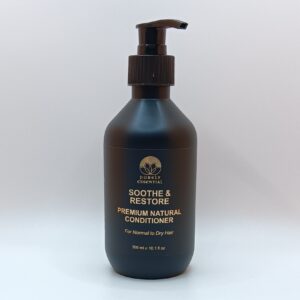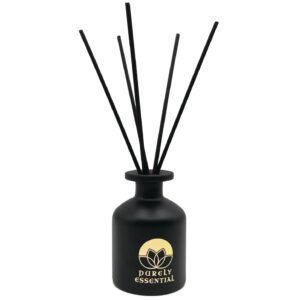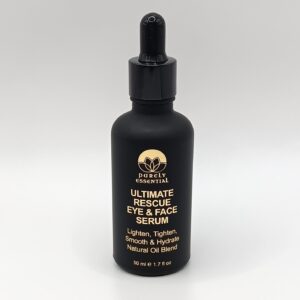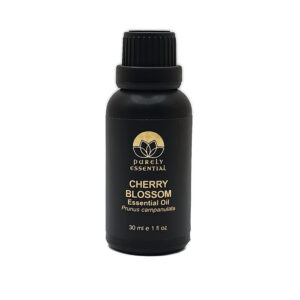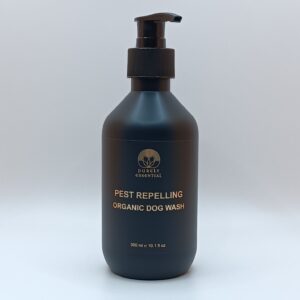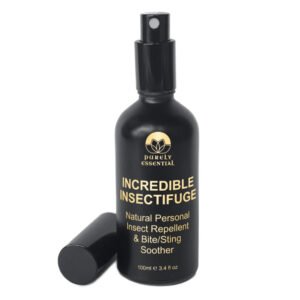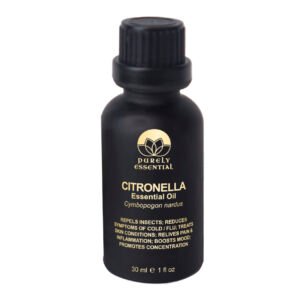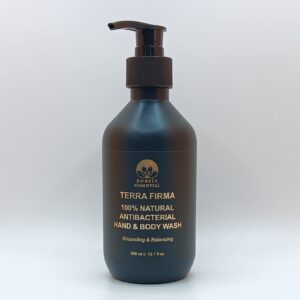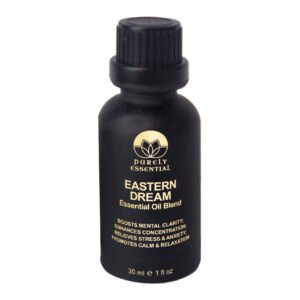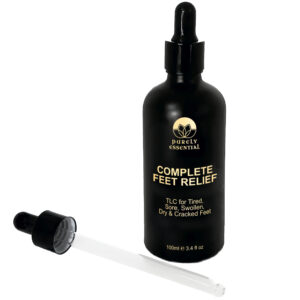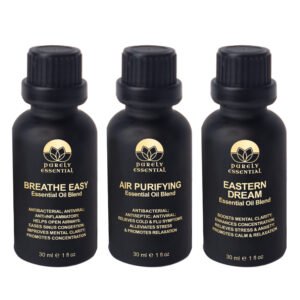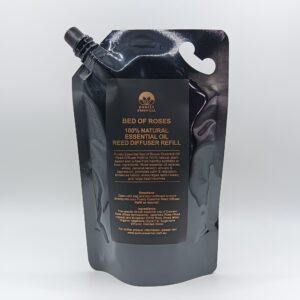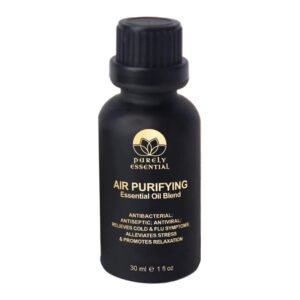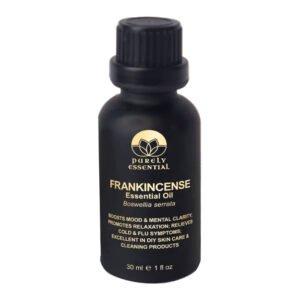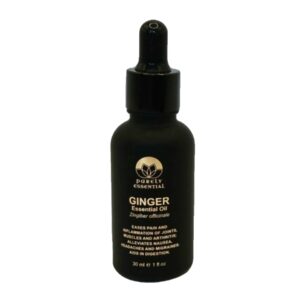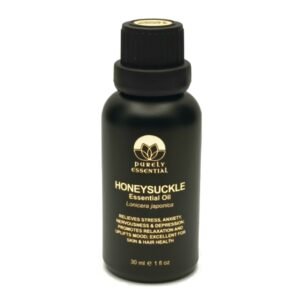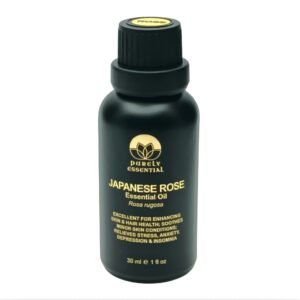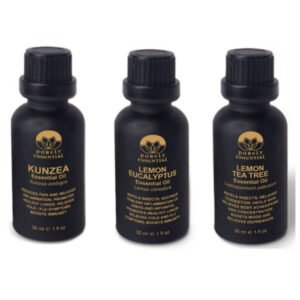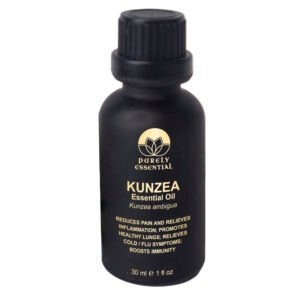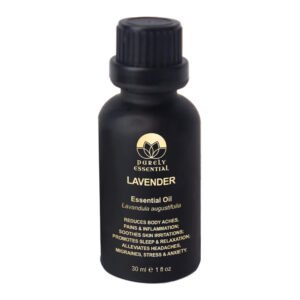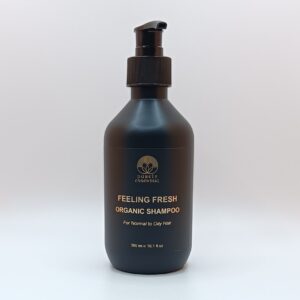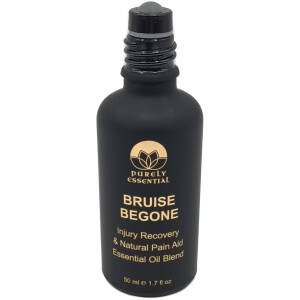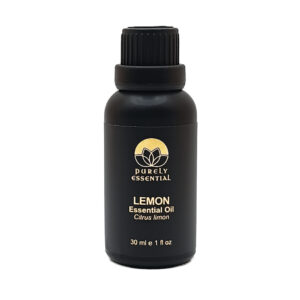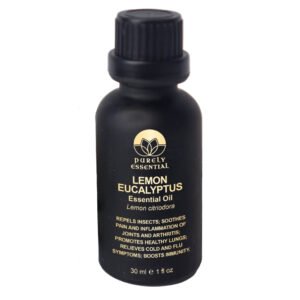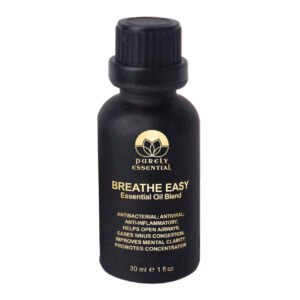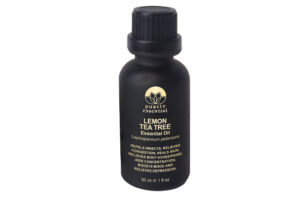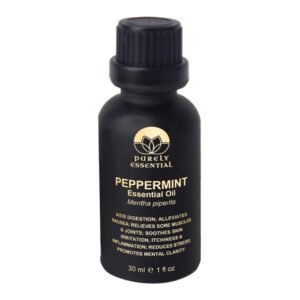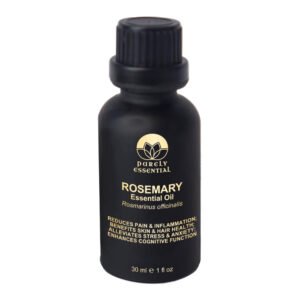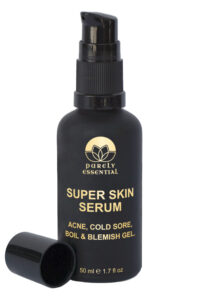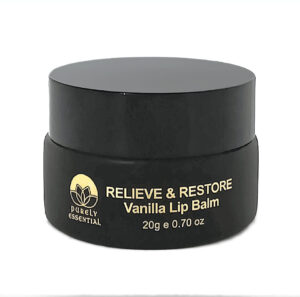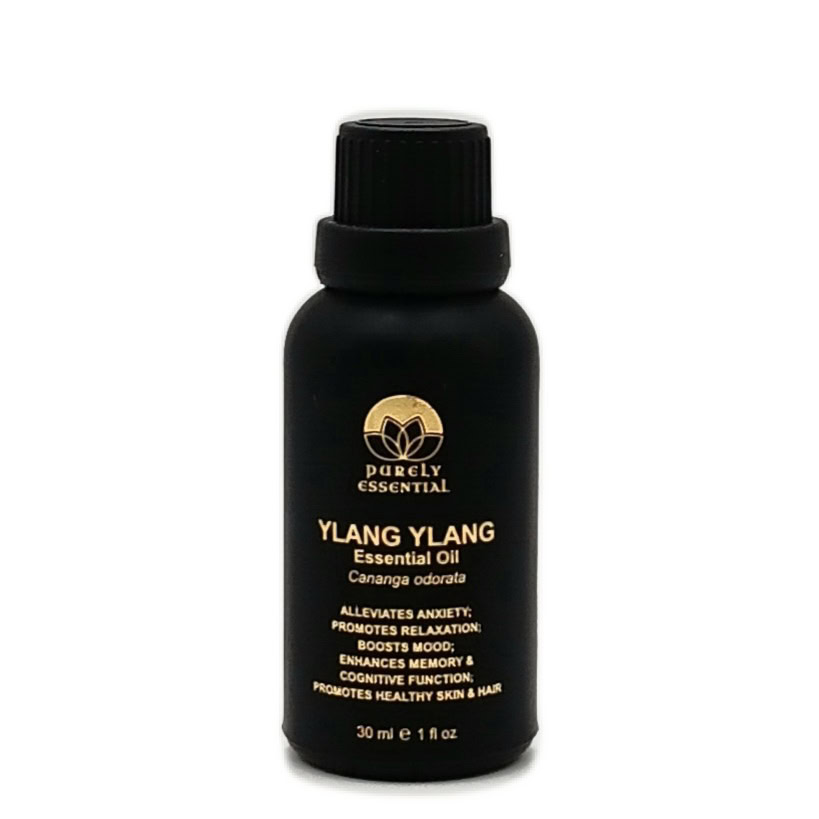Benefits of Essential Oils
There are many benefits of essential oils. Read below about the various essential oils that we use in our products.
Bergamot (Citrus bergamia) Essential Oil
Purely Essential Bergamot Essential Oil has a bright, fresh, citrusy and slightly floral scent. It has many uses and benefits to health and wellbeing.
It is a natural cleanser due to its antibacterial properties. It’s particularly good for oily skin, helping to unclog pores and balance sebum levels to get skin glowing for all the right reasons.
Several compounds in Bergamot Essential Oil have immunomodulatory, wound-healing activities, and anti-inflammatory properties.
Bergamot Essential Oil can be an effective treatment for acne, small wounds and skin conditions such as eczema and psoriasis.
Bergamot Essential Oil stimulates skin cell renewal and promotes an even and toned complexion. It naturally has powerful antibacterial and antimicrobial properties, making it an effective skin tonic and it’s particularly good for oily skin, helping to unclog pores and balance sebum levels.
Additionally, it has cooling properties that help soothe eyes. It improves blood circulation, increases collagen content and helps reduce swelling and dark circles around the eyes. This is an effective essential oil for eliminating dark circles under eyes.
The major compounds of Italian bergamot essential oil are limonene (37.2%), linalyl acetate (30.1%), linalool (8.8%), γ-terpinene (6.8%), and β-pinene (6.2%) Mondello et al., 1998
- ncbi.nlm.nih.gov/pmc/articles/PMC6392855/
- healthline.com/health/bergamot-oil
- ncbi.nlm.nih.gov/pmc/articles/PMC7559496/
- webmd.com/diet/health-benefits-bergamot
- medicalnewstoday.com/articles/bergamot-supplement-benefits
- onlinelibrary.wiley.com/doi/abs/10.1002/fsn3.903
- sciencedirect.com/topics/medicine-and-dentistry/bergamot-oil
- frontiersin.org/articles/10.3389/fphar.2015.00036/full
- draxe.com/essential-oils/bergamot-oil/
- mdpi.com/1424-8247/16/1/128
- tandfonline.com/doi/full/10.1080/13880209.2023.2197010
- researchgate.net/publication/315631793_Bergamot_Citrus_bergamia_Essential_Oil_Inhalation_Improves_Positive_Feelings_in_the_Waiting_Room_of_a_Mental_Health_Treatment_Center_A_Pilot_Study_Essential_Oil_Inhalation_Improves_Positive_Feelings
- intrepidmentalhealth.com/blog/12-essential-oils-for-a-better-nights-sleep
- sleepfoundation.org/sleep-aids/best-essential-oils-for-sleep
- news-medical.net/health/Aromatherapy-for-Dementia.aspx
- degruyter.com/document/doi/10.1515/znc-2019-0229/html
- academic.oup.com/jac/article/59/2/305/725087
Cherry Blossom (Prunus campanulata) Essential Oil
Purely Essential Cherry Blossom essential oil has a enticing and soothing floral scent and has many known benefits to health and wellbeing.
In aromatherapy, this essential oil is a popular choice for reducing stress and anxiety. It contains compounds that studies have shown to regulate hormone levels in the body, including estrogen. Its sweet fragrance uplifts mood, enhances feelings of well-being, promotes relaxation and improves sleep quality.
Cherry Blossom essential oil boasts hydrating and nourishing properties for skin which promote smoother, more supple skin. Due to its anti-inflammatory properties, it soothes irritated skin, and reduces redness and inflammation associated with various skin conditions. It is particularly excellent for dry or sensitive skin types.
Being rich in antioxidants, Cherry Blossom essential oil is anti-aging, excellent in combating oxidative stress and helps to protect skin cells from damage caused by free radicals. It has long been used to improve overall skin condition and vitality.
Cherry blossom essential oil can also help relieve and calm an irritated scalp, reduce inflammation, help to treat dandruff and promote a healthier environment for hair growth.
Cherry Blossom essential oil can impart a luxurious shine and improve the overall texture of hair, making it healthier, softer, smoother and more manageable.
Prunus campanulata is commonly known as Taiwan Cherry, Formosan Cherry and Bellflower Cherry. Many flowering cherry cultivars have been shown to have originated from Prunus campanulata, therefore studies show many varieties share similar beneficial properties.
- pmc.ncbi.nlm.nih.gov/articles/PMC6465379/
- healthbenefitstimes.com/taiwan-cherry/
- nature.com/articles/s41598-020-80891-0
- pubmed.ncbi.nlm.nih.gov/25065693/
- researchgate.net/profile/Raunak-Varshney/publication/51561274_Chemical_Constituents_of_the_Genus_Prunus_and_their_Medicinal_Properties/links/54759aac0cf2778985aee712/Chemical-Constituents-of-the-Genus-Prunus-and-their-Medicinal-Properties.pdf
- tokudaw.com/blog/health-secrets-of-cherry-blossoms
- mdpi.com/2073-4425/14/2/389
Citronella (Cymbopogon nardus) Essential Oil
Purely Essential Citronella essential oil has a fresh, citrus-like aroma and has long been used in many applications for its benefits to health and wellbeing.
The many properties of Citronella essential oil include anti-inflammatory, antispasmodic, antimicrobial, antibacterial, antifungal, stimulant, tonic, relaxant, antidepressant, diuretic and insect repelling.
Citronella is most commonly known for its excellent insect repelling properties and is effective on mosquitoes, midges, sandflies, fleas, ticks, black flies and march/horse flies. Due to its anti-inflammatory properties, it aids in healing insect bites and is shown to boost healing of skin.
In addition to healing insect bites, Citronella essential oil facilitates the healing of skin conditions such as acne, eczema and dermatitis, and its protective qualities reduce the chances of skin damage caused by UV exposure.
It has the ability to slow the look of aging especially in mature, scarred or blemished complexions, and is used to treat warts, age spots and fungal infections. It is also brilliant for deodorising and eliminating bacteria that causes bad body odour.
When either added to a hot bath or used topically in a carrier oil, Citronella essential oil is reputed to ease body cramps (including menstrual cramping), muscle spasms, swelling, inflammation and pain.
In aromatherapy, it can help reduce stress, ease anxiety, uplift mood, boost energy, relieve headaches and migraines, alleviate congestion and sinusitis, and support healthy respiratory function.
Due to its antimicrobial, antiseptic, antibacterial and antifungal properties, as well as its fresh and citrusy aroma, it makes a fantastic natural air freshener and addition to any DIY cleaning product.
Major Constituents found in citronella essential oil are geraniol, trans-citral, cis-citral, geranyl acetate, citronellal and citronellol. (Nakahara, 2013)
- pubmed.ncbi.nlm.nih.gov/30019646
- healthline.com/health/citronella-oil
- jstage.jst.go.jp/article/jarq/37/4/37_249/_article
- pubmed.ncbi.nlm.nih.gov/21481108/
- ncbi.nlm.nih.gov/pmc/articles/PMC4377886/
- pubmed.ncbi.nlm.nih.gov/23081773/
- pubmed.ncbi.nlm.nih.gov/15609890
- ncbi.nlm.nih.gov/pmc/articles/PMC3059459/
- draxe.com/essential-oils/citronella-oil/
- netmeds.com/health-library/post/citronella-essential-oil-5-astonishing-health-benefits-of-this-herbal-tincture
- pubmed.ncbi.nlm.nih.gov/8893526/
- sciencedirect.com/science/article/pii/S2221169115001033
- pubmed.ncbi.nlm.nih.gov/?term=Citronella+Essential+oil
Clove Bud (Syzygium aromaticum) Essential Oil
With its warming and topical anesthetic effect, Clove Bud essential oil is highly effective for pain and inflammation and assists overworked bodies by easing tension and tired, fatigued and sore muscles. Because clove buds have been traditionally used as a meat tenderiser, the essential oil is brilliant for softening hard muscles and body tension when 2-3 drops are applied directly to affected area.
Clove bud essential oil also relieves respiratory conditions such as cough and asthma especially when used in a diffuser, supports a healthy immune system and is beneficial as a digestive support when massaged onto the abdomen. With its antimicrobial, antiseptic and antifungal properties, it has shown in studies to kill bacteria and fungi, so it is excellent for DIY cleaning products and even applied to the skin in creams, scrubs, lotions or carrier oil for treating skin conditions.
Major Constituents found in Clove Bud essential oil are eugenol, eugenyl acetate, B-cariofileno, a-humulene, B-pinene, limonene, farsnesol, benzaldehyde, 2-heptanone and ethyl hexanoate. (Cortés-Rojas, 2014)
- ncbi.nlm.nih.gov/pmc/articles/PMC6060867
- healthline.com/health/clove-essential-oil
- draxe.com/essential-oils/clove-oil-uses-benefits/
- pubmed.ncbi.nlm.nih.gov/15720571/
- researchgate.net/publication/266412585_Antimicrobial_Activity_of_Essential_Oils_Against_Five_Strains_of_Propionibacterium_acnes
- ncbi.nlm.nih.gov/pmc/articles/PMC6064118/
- sciencedirect.com/science/article/abs/pii/S1878818122001979
- pubmed.ncbi.nlm.nih.gov/28382655/
- researchgate.com/publication/228633937
- ncbi.nlm.nih.gov/pmc/articles/PMC8352679/
- pubmed.ncbi.nlm.nih.gov/21796701/
- pubmed.ncbi.nlm.nih.gov/28407719/
- pubmed.ncbi.nlm.nih.gov/?term=Clove+Bud+Essential+Oil
Damask Rose (Rosa damascena) Essential Oil
Damask Rose (Rosa damascena) essential oil is highly effective in relieving stress, nervous tension, anxiety and depression.
It is reputable for promoting relaxation and restful sleep. Additionally it helps alleviate, reduce severity and prevent headaches, migraines and nausea.
Because of its wonderfully beneficial properties, we use high only quality, therapeutic grade Damask Rose essential oil in our Floral Bouquet Pure Essential Oil Blend, Bed of Roses Natural Reed Diffuser & Refill, Floral Bouquet Natural Reed Diffuser & Refill, Floral Heaven Organic Shampoo, Floral Heaven Premium Natural Conditioner, Floral Heaven Natural Hand & Body Wash, and Ultimate Rescue Eye & Face Serum.
Eucalyptus (Eucalyptus globulus) Essential Oil
Eucalyptus essential oil has multiple known properties including antifungal, antibacterial, anti-inflammatory, analgesic, antispasmodic, antiviral, expectorant, antioxidant, decongestant, anticonvulsant, antimicrobial, antiseptic and anesthetic.
Along with a cooling effect on muscles, Eucalyptus essential oil is commonly used to relieve muscle soreness and minor pain including arthritic pain, reduce swelling and inflammation, ease muscle spasms and stimulate healthy circulation. It is also said to be beneficial for the respiratory system and improves respiratory conditions, to support healthy lung function and to boost the immune system.
Eucalyptus has been shown to be highly effective as an insect repellent for mosquitoes, midges, ticks, leeches, sandflies, black flies and horse flies. It is also known to assist in treating skin conditions including wounds and skin irritations such as eczema and cold sores, boosting mental clarity, alleviating headaches and earaches, and helps fight seasonal allergies and cold/flu symptoms.
Major Constituents found in Eucalyptus essential oil are 1,8-cineole (ecalpytol) and a-pinene. (Sebei, 2015)
- healthline.com/health/9-ways-eucalyptus-oil-can-help
- prevention.com/health/a30615989/eucalyptus-oil-benefits/
- pubmed.ncbi.nlm.nih.gov/287582221/
- pubmed.ncbi.nlm.nih.gov/23853660/
- pubmed.ncbi.nlm.nih.gov/29986399/
- webmd.com/vitamins-and-supplements/ss/slideshow-eucalyptus-oil-benefits-and-uses
- pubmed.ncbi.nlm.nih.gov/25654423/
- pubmed.ncbi.nlm.nih.gov/29141025/
- pubmed.ncbi.nlm.nih.gov/24261680/
- jstage.jst.go.jp/article/jos/67/8/67_ess18005/_article
- pubmed.ncbi.nlm.nih.gov/1994967/
- medicalnewstoday.com/articles/266580
- pubmed.ncbi.nlm.nih.gov/34959612/
- sciencedirect.com/science/article/pii/S2667031321000713
Frankincense (Boswellia serrata) Essential Oil
Frankincense (Boswellia serrata) Essential Oil is earthy and warming with a sweet and spicy, woody aroma. This particular Frankincense variety is known for its many uses and benefits, and is commonly regarded as the best variety for topical applications.
Frankincense Essential Oil comes from trees in the Boswellia family and has been used for thousands of years for religious ceremonies, perfumes, cosmetics, and for its many therapeutic and healing benefits.
Boswellia serrata is native to India, Africa and the Arabian Peninsula and can be regarded as the best variety for topical use, for its strong anti-inflammatory properties, and its numerous benefits to health and wellbeing.
Studies have shown that Boswellia serrata Essential Oil is an effective anti-inflammatory, painkiller and can even prevent loss of cartilage. It has been used to treat arthritic conditions such as osteoarthritis and rhuematoid arthritis, and for boosting the body’s immune response.
Frankincense Essential Oil has the ability to eliminate cold and flu germs from the home, and has also been used to help treat asthma. Due to its antimicrobial and antibacterial properties, it can be a beneficial ingredient for natural DIY household cleaning products.
Frankincense Essential Oil has shown to strengthen skin, improve skin tone, help support elastin and hyaluronic acid to improve the appearance of skin firmness, and to improve elasticity and minimising wrinkles. It bolsters the skin’s defence mechanisms against bacteria or blemishes, evens skin tone, lifts skin, reduces the appearance of dark spots, blemishes, acne, scars, stretch marks, as well as treating wounds including surgical wounds.
Frankincense Essential Oil helps heal dry or cracked skin, reduce redness, has a soothing effect on skin irritations and helps relieve skin conditions such as eczema and contact dermatitis.
Research has also shown Frankincense Essential Oil can prevent and naturally support oral health problems such as gingivitis, bad breath, cavities, toothaches, mouth sores and other infections from occurring from plaque-induced gingivitis.
In aromatherapy, Frankincense Essential Oil has been shown to reduce heart rate and lower blood pressure. It has shown ability to reduce anxiety and depression due to the compounds Incensole and Incesole Acetate that are found in Frankincense. It’s grounding and aromatic scent has a calming effect that can naturally induce relaxation and sleep.
It also acts as an anti-inflammatory in the nasal passages, opening up breathing passages and making breathing easier, including for those with allergies or asthma. It provides relief from coughing, cold and flu symptoms, and can treat excessive phlegm, especially in the lungs. Used in a diffuser, Frankincense essential oil helps reduce indoor pollution and deoderises any room.
Frankincense (Boswellia serrata) Essential Oil boasts antibacterial, antiseptic, antimicrobial, antifungal, expectorant and anti-flammatory properties.
- ncbi.nlm.nih.gov/pmc/articles/PMC3309643/
- researchgate.net/publication/334457998_Boswellia_gum_resin_and_essential_oils_Potential_health_benefits-An_evidence_based_review
- ncbi.nlm.nih.gov/pmc/articles/PMC7368679/
- ncbi.nlm.nih.gov/pmc/articles/PMC7368679/
- sciencedirect.com/science/article/abs/pii/B9780128192184000109
- pubmed.ncbi.nlm.nih.gov/27117114/
- ncbi.nlm.nih.gov/pmc/articles/PMC9268443/
- drugs.com/npp/frankincense-indian.html
- ncbi.nlm.nih.gov/pmc/articles/PMC5801908/
- pubmed.ncbi.nlm.nih.gov/9810030/
- sciencedirect.com/science/article/abs/pii/S0944711304701890?via%3Dihub
- medsci.org/v08p0615.htm
- researchgate.net/publication/12466811_Randomized_double_blind_trial_of_an_Ayurvedic_plant_derived_formulation_for_treatment_of_rheumatoid_arthritis
- webmd.com/vitamins/ai/ingredientmono-63/boswellia-serrata
Gardenia (Gardenia jasminoides) Essential Oil
Purely Essential Gardenia essential oil is derived via steam distillation from the fragrant flowers of Gardenia jasminoides. It is known for its anti-inflammatory, antibacterial, antioxidant, analgesic, antifungal, antiseptic, detoxicant and antispasmodic properties.
In aromatherapy, Gardenia essential oil is used for its calming and mood-boosting effects. It helps treat depression, anxiety, stress, fatigue, emotional exhaustion, brain fog and headaches.
It has been shown to enhance cognitive function, and improve memory and concentration. Gardenia essential oil can also help relieve symptoms of colds, respiratory conditions, sinus infections and congestion.
Topically used in a carrier oil, it is used to reduce muscle spasms, relieve menstrual pain, fight bacterial infections and protect minor wounds. It can help manage minor pain and inflammation, and is sometimes used during labor and delivery for pain relief and comfort.
It can be used in diffusers, for making your own candles or perfumes, can be added to your favourite carrier oil for topical applications, in DIY skin and hair care recipes or can even be added to your existing products to enhance benefits.
- pmc.ncbi.nlm.nih.gov/articles/PMC9145545/
- draxe.com/essential-oils/gardenia/
- scispace.com/papers/therapeutic-effectiveness-of-gardenia-jasminoides-on-type-2-3wowq2elf7
- inabj.org/index.php/ibj/article/view/3023
- researchgate.net/publication/345669287_molecules_Chemical_Composition_of_Essential_Oil_from_Flower_of_'Shanzhizi'_Gardenia_jasminoides_Ellis_and_Involvement_of_Serotonergic_System_in_Its_Anxiolytic_Effect
- thaiscience.info/journals/Article/JHRE/10893399.pdf
- nicolerobertsryder.com/16-ways-pure-gardenia-essential-oil-benefits-your-health/
- healthbenefitstimes.com/health-benefits-of-gardenia-essential-oil/
- nature.com/articles/s41598-018-27366-5
- sciencedirect.com/science/article/pii/S1021949816301740
- go.gale.com/ps/i.do?id=GALE%7CA659273159&sid=googleScholar&v=2.1&it=r&linkaccess=abs&issn=15407535&p=HRCA&sw=w&userGroupName=anon%7Eba50112d&aty=open-web-entry
- wjpr.s3.ap-south-1.amazonaws.com/article_issue/a8cee4d42b541e730876d81b0d6b0885.pdf
- pubs.acs.org/doi/abs/10.1021/acs.jafc.9b00433#
German Chamomile (Chamomilla recutita) Essential Oil
Chamomile is one of the oldest, most widely used and well-documented medicinal plants in the world and has been recommended for a variety of healing applications.
There are two common types of chamomile used medicinally/therapeutically today: German Chamomile (Chamomilla recutita) and Roman Chamomile (Anthemis nobilis).
These two varieties share active constituents that help soothe sensitive and problem skin. This makes them both beneficial in skincare products aimed at sensitive skin that is prone to inflammation and for use in a wide range of products such as cleansers, moisturisers, balms, serums, massage oils and other skin or haircare products.
German Chamomile (Matricaria recutita) Essential Oil contains a higher level of chamazulene, which gives it its distinctive deeper blue color and it is known for its anti-inflammatory properties.
Also known as Blue Chamomile, Hungarian Chamomile, and Single Chamomile, there are a variety of chemotypes find in the essential oil, all containing high amounts of α-bisabolol oxide, β-farnesene, and chamazulene.
German Chamomile Essential Oil has long been used for skin care due to its antioxidant, Vitamin A and Vitamin E content that research has shown to be beneficial for skin health. It helps heals wounds, sores and eases skin conditions such as eczema, psoriasis, dermatitis and rashes.
Additionally, studies have shown hyperpigmentation (which occurs when skin is overexposed to sun rays and other harmful environmental factors), is reduced when German Chamomile Essential Oil is regularly used topically. Simultaneously, this nourishing essential oil boasts astringent and brightening properties that will keep the skin clear and glowing, as well as help tighten pores and soften the skin.
In aromatherapy, aids insomnia, promotes sleep and relieves anxiety and depression. Studies have also shown that German Chamomile Essential Oil can help relax the bronchi, which are the airways linking the windpipe to the lungs. As a result, it may also relieve coughing.
Research has shown that German Chamomile Essential Oil has demonstrated Analgesic, Anti-Allergenic, Anti-Inflammatory, Antiphlogistic, Antispasmodic, Bactericidal and Carminative properties.
- ncbi.nlm.nih.gov/pmc/articles/PMC2995283/
- healthline.com/health/chamomile-oil
- draxe.com/essential-oils/roman-chamomile-essential-oil/
- ncbi.nlm.nih.gov/pmc/articles/PMC9611340/
- sciencedirect.com/topics/nursing-and-health-professions/chamomile
- medicalnewstoday.com/articles/314245#essential-oils-for-asthma
- healthnews.com/beauty/skin-care/benefits-of-chamomile-in-skincare/
- japsonline.com/admin/php/uploads/288_pdf.pdf
- spandidos-publications.com/10.3892/mmr.2010.377/download
- thieme-connect.com/products/ejournals/abstract/10.1055/s-0032-1307564?device=mobile&innerWidth=412&offsetWidth=412
- ema.europa.eu/en/documents/herbal-report/final-assessment-report-chamaemelum-nobile-l-all-flos_en.pdf
- mountsinai.org/health-library/herb/german-chamomile
- frontiersin.org/articles/10.3389/fphar.2021.706836/full
Ginger (Zingiber officinale) Essential Oil
Ginger essential oil is warming, energising, uplifting and has many known benefits to health and well being. Used topically for its wonderful and stimulating effect, it has been shown in studies to be beneficial for tired and sore bodies, and to ease pain and inflammation of joints, muscles and arthritic conditions. Additionally, it has been purported to assist in eliminating toxins and bacteria, to soothe redness of skin, inhibit the signs of skin damage and aging, and restore healthy colour and radiance to a dull complexion.
Ginger essential oil is renowned for alleviating nausea, headaches and migraines, and for easing stomach and bowel discomfort. In aromatherapy, it is used to soothe and reduce stress, anxiety, dizziness, lethargy and fatigue. Ginger essential oil has also been used to contribute to the health and cleanliness of the scalp by soothing dryness and itchiness, and it has been said to enhance healthier hair growth by stimulating and improving circulation to the scalp.
Major Constituents found in Ginger essential oil are a-Zingiberene, B-phellandrene, camphene, E-E-afarnesene, B-sesquiphellandrene, ar-curcumene, B-bisabolene and y-curcumene (Shirooye, 2016)
- ncbi.nlm.nih.gov/pmc/articles/PMC5115784/
- healthline.com/health/ginger-oil
- ncbi.nlm.nih.gov/pmc/articles/PMC5412204/
- pubmed.ncbi.nlm.nih.gov/30362875/
- ncbi.nlm.nih.gov/pmc/articles/PMC6196928/
- pubmed.ncbi.nlm.nih.gov/27841938/
- draxe.com/essential-oils/ginger-essential-oil/
- ncbi.nlm.nih.gov/pmc/articles/PMC4027350/
- pubmed.ncbi.nlm.nih.gov/24756059
- ncbi.nlm.nih.gov/pmc/articles/PMC3953654/
- pubmed.ncbi.nlm.nih.gov/24020099
- journals.sagepub.com/doi/10.1177/1934578X1601101035
- pubmed.ncbi.nlm.nih.gov/2214812
- ncbi.nlm.nih.gov/pmc/articles/PMC3604064
- pubmed.ncbi.nlm.nih.gov/?term=Ginger+Essential+Oil
Himalayan Cedarwood (Cedrus deodara) Essential Oil
Cedarwood essential oil contains Cedrine, Cedrol and Thujopsene and the properties of these components are anti-inflammatory, antispasmodic, antifungal, antiseptic, diuretic and insecticidal. It is proven to helps alleviate muscle, nerve and joint pain and inflammation including arthritic conditions. Research also suggests it supports healthy lung function and promotes clear breathing.
This aromatic essential oil is grounding and calming and in aromatherapy, and Cedrol has shown in studies to have a soothing effect on mood, making it beneficial for anxiety, reducing stress and supporting an overtaxed nervous system. Additionally, it has sedative qualities making it beneficial for insomnia and aiding in restful sleep. It has great benefits for the scalp and skin including conditions such as dandruff, hair loss, eczema and acne, especially when added to facial masks, scrubs, lotions and shampoo. Cedarwood essential oil is also found to help repel ticks, fleas and moths.
Major Constituents found in Cedarwood essential oil are cedrene, thujospene and B-cedrene (Yen, 2012)
- ncbi.nlm.nih.gov/pmc/articles/PMC5435909
- healthline.com/health/cedarwood-essential-oil
- pubmed.ncbi.nlm.nih.gov/24690252/
- webmd.com/balance/what-to-know-about-cedarwood-essential-oil
- draxe.com/essential-oils/cedarwood-essential-oil/
- pubmed.ncbi.nlm.nih.gov/26910133/
- ncbi.nlm.nih.gov/pmc/articles/PMC5376423/
- pubmed.ncbi.nlm.nih.gov/9828867/
- onlinelibrary.wiley.com/doi/abs/10.1002/ptr.3509
- pubmed.ncbi.nlm.nih.gov/24276200/
- thieme-connect.com/products/ejournals/abstract/10.1055/s-2003-41114
- liebertpub.com/doi/abs/10.1089/acm.2209.0277
- pubmed.ncbi.nlm.nih.gov/?term=cedrus+deodara
Honeysuckle (Lonicera japonica) Essential Oil
Purely Essential Honeysuckle essential oil has a sweet, floral aroma with many therapeutic benefits. Naturally extracted from the blossoms of Lonicera japonica via steam distillation, the essential oil is known for its soothing properties and versatility. It is a top choice for relaxation and self-care.
Renowned for its calming and mood boosting properties, Honeysuckle essential oil reduces stress and anxiety. Its enticing aroma helps to create a peaceful atmosphere, enhancing emotional balance and mental clarity.
In aromatherapy, Honeysuckle essential oil can help reduce symptoms of cold & flu due to its antimicrobial, antiseptic, antiviral and antibiotic properties.
It is also excellent for promoting and improving quality of sleep, aiding in insomnia and restlessness. It boasts the ability to promote relaxation and ease tension has made it a popular choice for individuals looking to improve the quality of their sleep.
Research has shown that it contains insecticidal chemicals. These chemical compounds demonstrate remarkable ability in repelling insects, particularly mosquitoes, offering a safer and more environmentally-friendly alternative to traditional chemical insect repellents.
Honeysuckle essential oil demonstrates antibacterial, antimicrobial, antiviral, anti-inflammatory, nervine, sedative and insecticidal, antidepressant and antibiotic properties.
Caution: Avoid using topically during pregnancy.
- pmc.ncbi.nlm.nih.gov/articles/PMC4464489/
- mdpi.com/1420-3049/28/12/4828
- journals.sagepub.com/doi/abs/10.1177/1934578X1200700525
- sciencedirect.com/topics/biochemistry-genetics-and-molecular-biology/lonicera-japonica
- tellus.ars.usda.gov/stories/articles/honeysuckle-s-sweet-scent-not-so-kind-to-mosquitoes
- researchgate.net/publication/229154285_Chemical_Composition_of_the_Essential_Oils_from_the_Flower_Leaf_and_Stem_of_Lonicera_japonica
- pmc.ncbi.nlm.nih.gov/articles/PMC7127058/
- journals.sagepub.com/doi/full/10.1177/1934578X211008318
- organicfacts.net/health-benefits/essential-oils/honeysuckle-essential-oil.html
- pubmed.ncbi.nlm.nih.gov/30632272/
- bmccomplementmedtherapies.biomedcentral.com/articles/10.1186/1472-6882-12-226
- pmc.ncbi.nlm.nih.gov/articles/PMC10650709/
Japanese Rose Essential Oil
Purely Essential 30ml Japanese Rose essential oil is derived from Rosa rugosa flowers via steam distillation. It is calming, soothing and uplifting with its captivating and enticing floral aroma, and is highly prized for its aromatherapy, skin and hair health benefits.
In skincare, Japanese Rose essential oil is used to hydrate and rejuvenate skin, help restore restore the skin’s natural moisture balance, and to help reduce the appearance of fine lines and scarring. Japanese rose oil contains antioxidants that can also help protect the skin from environmental damage and aging, making it an excellent essential oil for dry, sensitive and mature skin types.
Research suggests that Japanese Rose essential oil can be helpful in managing skin conditions like eczema, psoriasis, and rosacea. It can assist in reducing skin irritations and the appearance of pigmentation due to its powerful anti-inflammatory and soothing properties. Additionally, it can also reduce redness and even out skin tone due to its valuable antioxidant properties.
Moreover, Japanese Rose essential oil has long been used for hair health. The vitamins and essential fatty acids in Rosa rugosa help nourish and strengthen hair follicles, leading to stronger, shinier, smoother and healthier hair and potentially reducing breakage. The antioxidants in Rosa rugosa, such as quercetin and other compounds, help protect hair from damage caused by free radicals and environmental stressors.
In aromatherapy, Japanese Rose essential oil is an effective natural mood booster with its calming, comforting and uplifting aroma. Studies have shown that it can help calm the body, reduce stress, anxiety and depression, and promote a positive mood.
It is a popular choice for those that struggle with insomnia and is renowned for improving sleep quality. Some studies have shown that Japanese Rose essential oil can also help alleviate symptoms like mood swings, headaches, and cramping associated with PMS and menopause.
In recent research, Japanese Rose essential oil has been shown to help protect plants from unwanted pests by enhancing potential disease resistance, as well as attracting predators of pests.
- pmc.ncbi.nlm.nih.gov/articles/PMC5511972/
- onlinelibrary.wiley.com/doi/abs/10.1002/ffj.2730050406
- researchgate.net/publication/326093756_Medicinal_Components_and_Pharmacological_Effects_of_Rosa_rugosa
- jintegrativederm.org/article/136390-essential-oils-in-dermatology
- mdpi.com/1422-0067/25/21/11362
- sciencedirect.com/science/article/pii/S2405844023107389
- onlinelibrary.wiley.com/doi/abs/10.1002/ptr.7783
- healthline.com/health/rose-oil
- researchgate.net/publication/265052466_Composition_and_antimicrobial_activity_of_the_essential_oil_and_water_extract_from_Japanese_wild_Rosa_rugosa
- pmc.ncbi.nlm.nih.gov/articles/PMC4774500/
- jipb.net/EN/abstract/abstract25266.shtml
- pmc.ncbi.nlm.nih.gov/articles/PMC10758878/
- naturallivingfamily.com/essential-oils/benefits/rose-oil/
- sciencedirect.com/science/article/abs/pii/S0965229914001484
- pmc.ncbi.nlm.nih.gov/articles/PMC10046031/
- sciencedirect.com/science/article/pii/S0361923024000297
- pubs.acs.org/doi/abs/10.1021/acs.jafc.3c08905
- sj.jst.go.jp/news/202405/n0524-01k.html
- cabidigitallibrary.org/doi/full/10.1079/cabicompendium.47835
Kunzea (Kunzea ambigua) Essential Oil
Australian native Kunzea essential oil has several compounds that make it excellent for quick and soothing relief of tired and sore muscles and joints. Due to the anti-inflammatory properties, it is beneficial for arthritic conditions and pain management, invigorating muscles and assisting in the recovery process of physical activity such as a workout, sport or physically laborious work. It is also commonly used for easing muscle spasms, and increasing blood flow to calm painful nerve endings. Additionally, it promotes the rapid repair of soft tissue injuries such as sprains and strains. The key components target the source of pain by deeply penetrating layers of skin to promote the body’s own healing process.
Kunzea essential oil is fantastic in supporting healthy lung and airway function. The 2 major constituents are shown to effectively treat symptoms of colds, coughs, running nose, sore throat, asthma, nasal congestion, bronchitis and sinusitis. It is also purported to boost the immune system.
The analgesic, anti-inflammatory, antibacterial and antifungal properties are additionally beneficial for healing a multitude of skin conditions and infections such as acne, eczema, psoriasis, athlete’s foot, ringworm and other fungal and bacterial skin problems. Commonly called Tick Bush, Kunzea essential oil is not only effective as an insect repellent, but if already bitten, its anti-inflammatory properties reduce redness and stops the itch of bites.
In aromatherapy, the antiseptic and antibacterial qualities refreshes and creates a relaxing atmosphere and is proven to relieve stress, anxiety, depression, nervous tension, headaches and mental exhaustion when used in the home or office.
Major Constituents found in Kunzea essential oil are alpha-pinene, 1,8 cineole globulol, viridifloral, bicyclogermacrene and a-Terpinol. (Thomas, 2010)
- researchgate.net/publication/236651921_An_examination_of_the_leaf_oo;s_of_Tasmanian_Kunzea_ambigua_and_other_Kunzea_species
- eprints.utas.edu.au/14805/
- pubmed.ncbi.nlm.nih.gov/30156327/
- drugs.com/npp/kunzea-oil.html#24582465
- pubmed.ncbi.nlm.nih.gov/19960685/
- researchgate.net/publication/350710907_Kunzea_ambigua_SmDruce_and-Kunzea_flavescens_CT_Inhibit_the_Growth_of_Some_Bacterial_Triggers_of_inflammatory_Diseases
- gardeningwithangus.com.au/kunzea-essential-oil/
- discover.hubpages.com/health/Comparing-Australian-Essential-Oils-Fragonia-Kunzea-and-Tea-Tree
- dr-lobisco.com/more-kudos-for-kunzea-what-the-science-says-about-this-amazing-essential-oil/
- ecite.utas.edu.au/57792
- researchgate.net/publication/299653503_Can_kunzea_oil_Kunzea_ambigua_control_head_lice_Pediculus_humanus_capitis
- startsat60.com/lab/health-lab/kunzea-oil-discover-tasmanias-best-kept-secret-for-natural-arthritis-relief
- ecite.utas.edu.au/60259
- ncbi.nlm.nih.gov/pmc/articles/PMC4461961/
Lavender (Lavandula angustifolia) Essential Oil
Lavender essential oil has shown in studies to have many properties including anti-inflammatory, antifungal, antidepressant, antiseptic, antibacterial, antimicrobial, antispasmodic, analgesic, detoxifying, hypotensive and sedative effects.
One of the most popular essential oils, Lavender is a multipurpose oil reputable to relieve muscle spasms and muscle tension, reducing body aches and pains including joint, nerve and arthritic pain and inflammation.
Additional known benefits include soothing and healing inflamed and irritated skin conditions, boosting the immune system by helping relieve stress and nervous tension, promoting sleep and relaxation, alleviating headaches and migraines, promoting easy breathing and reducing coughs and colds, diminishing fatigue, increasing mental clarity and improving mood.
Major Constituents found in Lavender essential oil are linalool, linalyl acetate, 1,8-cineole, B-ocimene, terpinen-4-ol and camphor. (Pokajewicz, 2021)
- verywellmind.com/lavender-for-less-anxiety-3571767
- tandfonline.com/doi/abs/10.1080/07420520500263276?journalCode=icbi20
- ncbi.nlm.nih.gov/pmc/articles/PMC3159017/
- ncbi.nlm.nih.gov/pmc/articles/PMC5435909/
- ncbi.nlm.nih.gov/pmc/articles/PMC4843973/
- hindawi.com/journals/ecam/2013/361832/
- pubmed.ncbi.nlm.nih.gov/22517298/
- pubmed.ncbi.nlm.nih.gov/26247152/
- healthline.com/health/lavender-oil-for-skin
- medicalnewstoday.com/articles/265922
- healthline.com/health/what-lavender-can-do-for-you
- ncbi.nlm.nih.gov/pmc/articles/PMC3612440/
- draxe.com/essential-oils/lavender-oil-benefits/
- ncbi.nlm.nih.gov/pmc/articles/PMC5878871
Lemon (Citrus limon) Essential Oil
Purely Essential Lemon essential oil is extracted by cold pressing the fruit peel of lemon (Citrus limon), and it has a delicate, fresh and uplifting scent.
Lemon essential oil has long been used to alleviate stress, anxiety, depression, symptoms of colds and flu, and nausea including morning sickness. It is believed to be useful for keeping asthma under control because inhaling its aroma can help clear the nasal passages and sinuses.
In scientific studies, Lemon essential oil has also shown to energise and boost mood, increase neuroprotective function, memory and attention levels, especially those with Alzheimer’s.
It is excellent for cleaning metal surfaces, dishes, and clothes. It is also a great disinfectant, commonly used for air fresheners and cleaning surfaces such as butcher’s knives and blocks.
Used topically, it can help relieve pain, treat minor wounds and skin disorders such as acne, reduce excessive oil on the skin, improve overall skin condition, as well as treat dandruff and promote stronger, shiny and healthy hair.
Lemon essential oil is a popular ingredient for DIY cleaning products for its fresh scent and antibacterial, antimicrobial, antifungal and antiseptic properties.
It boasts antimicrobial, antibacterial, antimicrobial, antifungal, antiseptic, astringent, anti-inflammatory, antidepressant and antioxidant properties.
Major constituents found in Lemon Essential Oil are limonene, β-Pinene and γ-terpinene.(https://pmc.ncbi.nlm.nih.gov/articles/PMC10893099/)
- pmc.ncbi.nlm.nih.gov/articles/PMC7244039/
- sciencedirect.com/science/article/abs/pii/S2212958824001356
- healthline.com/health/lemon-essential-oil#reduce-anxiety-and-depression
- onlinelibrary.wiley.com/doi/abs/10.1002/smi.1158
- organicfacts.net/health-benefits/essential-oils/health-benefits-of-lemon-oil.html
- pmc.ncbi.nlm.nih.gov/articles/PMC9774566/
- draxe.com/essential-oils/lemon-essential-oil-uses-benefits/
- researchgate.net/publication/331051081_Effect_of_Inhaled_Lemon_Essential_Oil_on_Cognitive_Test_Anxiety_Among_Nursing_Students
- accscience.com/journal/IMO/2/1/10.36922/imo.5893
- nsj.org.sa/content/nsj/15/4/292.full.pdf
- pmc.ncbi.nlm.nih.gov/articles/PMC9201525/
- mdpi.com/2223-7747/13/4/524
- ajol.info/index.php/ebnr/article/view/285443/268963
- greatist.com/health/lemon-essential-oil-benefits
- tisserandinstitute.org/learn-more/lemon-oil-morning-sickness/
- iscientific.org/wp-content/uploads/2019/09/6-IJCBS-18-14-6.pdf
- pacificscents.com.au/wp-content/uploads/2023/06/Lemon-Essential-Oil-vs-lime.pdf
- medicalnewstoday.com/articles/324478
- examine.com/research-feed/study/dxXryd/?srsltid=AfmBOootdOHIHSOIHEHdiosu83fcbIelUjfpoj52_FdPPp2KBmIpEBL_
- onlinelibrary.wiley.com/doi/10.1002/brb3.2889
- etflin.com/article/228
Lemon Eucalyptus (Eucalyptus citriodora) Essential Oil
Australian native Lemon Eucalyptus essential oil is energising, revitalising and is a versatile oil with many benefits to health and well being. It is proven to be beneficial for physical discomfort and reducing inflammation especially after sport or physical exertion, and is known for boosting the immune system, and relieving cold and flu symptoms.
Lemon Eucalyptus is excellent in repelling insects including mosquitoes, midges, sandflies, black flies, horse flies, ticks, leeches, silverfish and cockroaches. It is also highly recommended for DIY cleaning products for its antiseptic and antibacterial properties, as well as for its refreshing scent. In aromatherapy, it clears and soothes promoting mental clarity, calming the mind and encouraging motivation during times of increased exhaustion.
Major Constituents found in Lemon Eucalyptus essential oil are Citronellal, geraniol, B-citronellol and S-cadinene (Costa et al., 2015)
- researchgate.net/publication/264868532_Bioactivity_of_Eucalyptus_citridora_leaves_essential_oil
- healthline.com/health/oil-of-lemon-eucalyptus
- pubmed.ncbi.nlm.nih.gov/19169833/
- medicalnewstoday.com/articles/lemon-eucalyptus-essential-oil
- ncbi.nlm.nih.gov/pmc/articles/PMC6163473
- bmccomplementmedtherapies.biomedcentral.com/articles/10.1186/s12906-020-02999-0
- ncbi.nlm.nih.gov/pmc/articles/PMC8706319
- walshmedicalmedia.com/open-access/seed-essential-oil-of-emeucalyptus-citridoraeam-evaluation-of-the-secondary-metabolites-radical-scavenging-antioxidant-antiinflamm-113295.html
- bioone.org/journals/journal-of-medical-entomology/volume-43/issue-4/0022-2585(2006)43%5b731%3aROOOLE%5d2.0.CO%3b2/Repellency-of-Oils-of-Lemon-Eucalyptus-Geranium-and-Lavender-and/10.1603/0022-2585(2006)43%5B731:ROOOLE%5D2.0.CO;2.short
- pubmed.ncbi.nlm.nih.gov/16892632/
- sciencedirect.com/science/article/abs/pii/S0023643812001429
- pubmed.ncbi.nlm.nih.gov/?term=Lemon+Eucalyptus+Essential+Oil%20itmedicalteam.pl/articles/health-benefits-of-the-fruit-essential-oil-of-eucalyptus-citriodora-secondarymetabolites-radical-scavenging-antioxidant-antiinflam.pdf&ved=2ahUKEwiSzcafxP79AhXspVYBHWdeCI0QFnoECCIQAQ&usg=AOvVaw3GzxObI27fCQWApG9uMfFLc
- itmedicalteam.pl/articles/health-benefits-of-the-fruit-essential-oil-of-eucalyptus-citriodora-secondarymetabolites-radical-scavenging-antioxidant–101703.html
- researchgate.net/publication/6893709_Repellency_of_Oils-of_Lemon_Eucalyptus_Geranium_and_Lavender_and_the_Mosquito_Repellent_MyggA_Natural_to_Ixodes_ricinus_Acari_Ixodidae_in_the_Laboratory_and_Field
Lemon Tea Tree (Leptospermum petersonii) Essential Oil
Australian native Lemon Tea Tree essential oil is invigorating, uplifting and is a versatile oil with many benefits to health and well being. The extremely high Citral content makes it a highly effective insect repellant for mosquitoes, sandflies, midges, bees, ants, all types of flies, fleas, ticks and leeches. Due to its anti-inflammatory, antiseptic, antibacterial, antimicrobial and antifungal properties treat skin conditions such as insect bites, stings including blue bottle stings, cuts, burns, acne, infected wounds, bruises and sunburn. The antimicrobial properties also kill the bacteria on skin that causes body odour.
Lemon Tea Tree essential oil also soothes inflammation and body aches and pain, especially chronic inflammation or muscle tension. It supports healthy lung and airway function and is an excellent natural antiseptic for skin infections. The germ killing properties and citrusy aroma also makes it excellent in DIY cleaning products. In aromatherapy, it energises and uplifts mood, relieves depression and aids in concentration.
Major Constituents found in Lemon Tea Tree essential oil are citronellal, citronellol, neral and geranial (Van Vuuren et al., 2014).
- pubmed.ncbi.nlm.nih.gov/17978807/
- ncbi.nlm.nih.gov/pmc/articles/PMC7174609/
- sciencedirect.com/science/article/pii/S0254629914000076
- researchoutput.csu.edu.au/en/publications/the-effect-of-leptospermum-petersonii-essential-oil-on-candida-al
- medcraveonline.com/JBMOA/JBMOA-07-00238.pdf
- journals.sagepub.com/doi/10.1177/1934578X800300531?icid=int.sj-abstract.similar-articles.2
- steemit.com./leptospermum/@ctrl-alt-nwo/lemon-scented-tea-tree-aussie-native
- espace.library.uq.edu.au/view/UQ:296934
- jac.oxfordjournals.org/content/65/2/285.full.pdf&ved-2ahUKEwj4ndzhnYD-AhXBrVYBHUvfBA04KBAWegQIERAB&usg=AOvVaw0es0sysKPsnL4Nges228Ah
- herbalgram.org/resources/herbclip/issues/2017/bin_568/041731-568/
- phcogcommn.org/wp-content/uploads/2021/08/PharmacognCommn_6_4_-215.pdf&ved=2ahUKEwi4mlvfoID-AhXdr1BHe6gCb84PBAWegQIAxAB&usg=AOvVaw2HuUGOGavWBIUhYLJBMcn
- bmcchem.biomedcentral.com/articles/10.1186/1752-153X6-38
- pubmed.ncbi.nlm.nih.gov/19852219/
- pubmed.ncbi.nlm.nih.gov/21864348/
Lemongrass (Cymbopogon nardus) Essential Oil
Essential Lemongrass oil is prized for its anti-inflammatory, antiseptic, astringent and muscle relaxing qualities. It contains Citral which works quickly to reduce inflammation, swelling and helps alleviate pain due to inflammation such as arthritic conditions and injuries. With its antibacterial and antifungal properties, it is purifying and toning to the skin and is beneficial in treating skin infections and fungal skin conditions. It is also shown in studies to benefit immune system health and aid in treating insomnia as it purports to also have a sedative effect.
Lemongrass essential oil contains organic compounds called Aldehydes which are a natural bug deterrent, and have shown to repel mosquitoes, fleas, ticks and many other biting insects. Because of the antibacterial and antifungal properties combined with its citrusy aroma, Lemongrass essential oil is also excellent in DIY air fresheners and cleaning products. The uplifting, energising scent of lemongrass is shown in studies to relieve anxiety, stress, depression, to support concentration and reduce fatigue, as well as to relieve headaches and migraines.
Major Constituents found in Lemongrass essential oil are neral, isoneral, geranial, isogeranial, geraniol, geranyl acetate, citronellal, citronellol, germacrene-D and elmol (Mukarram et al., 2021).
- sciencedirect.com/science/article/pii/S1995764510601290
- healthline.com/health/lemongrass-essential-oil
- pubmed.ncbi.nlm.nih.gov/25242268/
- onlinelibrary.wiley.com/doi/abs/10.1002/%28SICI%291099-1573%28199611%2910%3A7%3C551%3A%3AAID-PTR1908%3E3.0.CO%3B2-Q
- researchgate.net/publication/319092284_Effect_of_Lemongrass_oil_on_rheumatoid_arthritis
- researchgate.net/publication/278411223_Physiological_and_Psychological_Effects_of_Lemongrass_and_Sweet_Almond_Massage_Oil
- hindawi.com/journals/ecam/2011/467134/
- medicalnewstoday.com/articles/325209
- jpsr.pharmainfo.in/Documents/Volumes/vol9Issue02/jpsr09021734.pdf
- ncbi.nlm.nih.gov/pmc/articles/PMC3217679/
- draxe.com/essential-oils/lemongrass-essential-oil
- pubmed.ncbi.nlm.nih.gov/26366471/
- sciencedirect.com/science/article/pii/S221400851730010X
- pubmed.ncbi.nlm.nih.gov/25242268/
- pubmed.ncbi.nlm.nih.gov/?term=Lemongrass+Essential+Oil
Lime (Citrus aurantiifolia).Essential Oil
Lime (Citrus aurantiifolia) essential oil is invigorating, cleansing, and purifying with a fresh, vibrant yet sweet, citrus scent. It exhibits antioxidant, anti-aging, analgesic, anti-inflammatory, insecticidal, antifungal, antiviral and antibacterial properties.
Lime essential oil’s antioxidant properties help combat free radicals and oxidative stress. It aids in the reduction of acne, ageing indicators like fine lines, sun spots, and wrinkles, and its astringent characteristics help keep the skin tight and enhance a clearer appearance. It can assist in the lightening of skin tone, as well as balancing skin complexion due to the high levels of vitamin C, carotenes and enzymes.
Lime essential oil is cleansing and helps promote healthy hair growth and strengthen the hair follicles by providing them with needed nutrients. In addition, the citric acid found in lime essential oil can help remove dead skin cells from the scalp, which allows for new and healthy hair growth.
Lime essential oil is known for its antiviral properties and this can make it an effective natural remedy for symptoms of cold and flu. Due to its high limonene content, its believed to boost the immune system when inhaled.
Lime essential oil contains high ester substances so that has pharmacological effects such as natural analgesic effects to relieve muscle pain. When used in massage application, it has seen beneficial results in reducing cellulite and fluid retention. Studies have found that Lime essential oil used as topical massage therapy oil is better for accelerating the DOMS (delayed-onset muscle soreness). It has also been suggested to help improve rheumatism, arthritis and poor circulation.
The antibacterial properties of lime essential oil along with its fresh scent makes it a wonderful ingredient in home cleaning. You can add a few drops of this oil to your current household cleaners, or use it to make your own natural cleaning products. Lime essential oil can cut through tough grease, which is why it’s a popular ingredient in kitchen cleaning products. It can also be used to remove unpleasant room smells in DIY air fresheners, or in aromatherapy diffusers and in a oil warmer/burner.
Lime essential oil is known for its healing benefits which can be attributed to anti-inflammatory, astringent, analgesic, stimulant, antiseptic, soothing and energising properties. You can use diluted Lime Oil to treat minor cuts, scrapes, burns, and chilblains. Lime Oil is phototoxic, so always use it at low dilutions (the recommended dermal maximum is 0.7%).
In aromatherapy, lime essential oil has been purported to have an uplifting quality that helps alleviate stress, uplift mood, combat feelings of lethargy and promote a sense of well-being.
The major constituents of Citrus aurantiifolia are limonene (58.4%), Ɓ-pinene (15.4%), Ɓ-terpinene (8.5%), and citral (4.4%).
- ncbi.nlm.nih.gov/pmc/articles/PMC9774566/
- researchgate.net/publication/286042575_Effects_of_aromatherapy_massage_with_lime_essential_oil_on_stress
- mdpi.com/2076-3921/11/12/2374
- bmccomplementmedtherapies.biomedcentral.com/articles/10.1186/s12906-024-04380-x
- ncbi.nlm.nih.gov/pmc/articles/PMC10008347/
- journals.sagepub.com/doi/pdf/10.1177/1934578X1200701128%23:~:text%3Daurantifolia%2520possesses%2520important%2520spasmolytic%2520properties,%252C%2520and%2520citral%2520(4.4%2525).&ved=2ahUKEwj7tJ-azLyGAxWHcmwGHeBaBl4QFnoECA8QBg&usg=AOvVaw2iIN8Q1moROG76C8uvJVaF
- hindawi.com/journals/bmri/2021/5565956/
- pubmed.ncbi.nlm.nih.gov/20623616/
- researchgate.net/publication/343226202_A_comprehensive_review_on_Citrus_aurantifolia_essential_oil_its_phytochemistry_and_pharmacological_aspects
- ncbi.nlm.nih.gov/pmc/articles/PMC9287566/
- citeseerx.ist.psu.edu/document?repid=rep1&type=pdf&doi=d7fa5aea778605949c1e96d8c755b803f8d11080
- pubmed.ncbi.nlm.nih.gov/36919127/
- hindawi.com/journals/ecam/2018/3624094/
- journals.sagepub.com/doi/10.1177/1934578X211072713?icid=int.sj-full-text.citing-articles.10
- mdpi.com/2073-4395/12/3/735
- ncbi.nlm.nih.gov/pmc/articles/PMC7154898/#:~:text=Citrus%20essential%20oils%20(CEOs)%20exhibit,industries%20%5B11%2C12%5D.
- sciencedirect.com/science/article/abs/pii/S1773224722000971
- ncbi.nlm.nih.gov/pmc/articles/PMC6770194/
Neem Seed Essential Oil
The essential oil of Neem Seed is highly effective as a natural insect repellent from a multitude of pests including mosquitoes, midges, ticks, black flies and horse flies. In mosquitoes, it both repells and disrupts their growth and reproduction including killing eggs and larvae. In addition to being a fantastic repellent, Neem Seed essential oil is also fantastic in treating bites (such as ant bites), stings (such as blue bottle stings) and cuts.
Neem Seed essential oil is highly beneficial for the skin. It is able to balance oil production, heal wounds, stimulate collagen formation, actively works to treat acne as well as reduce post acne scars, minimises skin inflammation including from sun damage, and due to its essential fatty acid content is an excellent moisturiser. It works as a natural alternative to heal the skin tissue from within and reduce hyperpigmentation and scars. It is also beneficial for hair care and treatment, and has shown to improve hair growth especially in those suffering from hair loss.
Major Constituents found in Neem Seed essential oil are loeic acid, palmitic acid, stearic acid, linoleic acid and arachidic acid (Swapna sonale et al., 2018).
- medicalnewstoday.com/articles/327179
- ncbi.nlm.nih.gov/pmc/articles/PMC6558881/
- ncbi.nlm.nih.gov/books/NBK234637/
- sciencedirect.com/science/article.abs/pii/S1011134416303323
- pubmed.ncbi.nlm.nih.gov/23835719/
- semanticscholar.org/paper/The-combined-efficacy-of-neem-(Azardirachta-indica)-Boanyah-Brenyah/f6aa2cc0eb94aa12d2b08db92d26bddef325b08e
- ncbi.nlm.nih.gov/pmc/articles/PMC6558881/
- healthline.com/health/neem-oil-for-skin
- ncbi.nlm.nih.gov/pmc/articles/PMC4734358
- draxe.com/beauty/neem-oil/
- sciencedirect.com/science/article/pii/S1756464620303959
- pubmed.ncbi.nlm.nih.gov/?term=Neem+seed+Essential+oil
- ncbi.nlm.nih.gov/pmc/articles/PMC4791507/
- medicinenet.com/what_is_neem_oil_used_for/article.htm
Citrus aurantium Essential Oil
Neroli essential oil is extracted from the small, white, waxy flowers of the Bitter Orange (Citrus aurantium) tree via steam distillation. It has a delicate, sweet, fresh, citrus-like floral aroma.
It demonstrates antiseptic, antibacterial, antimicrobial, antifungal, lcarminative, cicatrizant, cytophylactic, antioxidant, disinfectant, aphrodisiac, antispasmodic, anticonvulsant, emollient, sedative, nervine and neurotonic properties.
It’s known for its ability to regenerate skin cells, improve elasticity of skin, and reduce the appearance of wrinkles, scars and stretch marks. It is useful for treating bacterial skin conditions such as acne and rashes, and helps maintain the balance of sebum production, making it an excellent choice for all skin types.
Neroli has been shown in studies to be an effective and therapeutic choice for management of pain and inflammation (acute & chronic). It demonstrates the ability to reduce central and peripheral sensitivity to pain, and relieve anxiety and perceived pain during labour.
Research also indicates that the inhalation of Neroli essential oil soothes nerves and feelings of grief or despair, helps lower blood pressure, relieves menopausal symptoms, reduces cortisol levels, improves estrogen concentrations and can even help in management of seizures.
- pmc.ncbi.nlm.nih.gov/articles/PMC8871902/
- rsdjournal.org/index.php/rsd/article/view/21447
- researchgate.net/publication/244933553_Inhalation_of_Neroli_Essential_Oil_and_Its_Anxiolytic_Effects
- healthline.com/health/neroli-oil
- rsdjournal.org/index.php/rsd/article/download/21447/19051/258534
- draxe.com/essential-oils/neroli-essential-oil/
- semanticscholar.org/paper/Inhalation-of-Neroli-Essential-Oil-and-Its-Effects-Chen-Cheng/3faea6373941de982e3c192dd809628a185bc517
- researchgate.net/publication/258114458_Chemical_composition_and_in_vitro_antimicrobial_and_antioxidant_activities_of_Citrus_aurantium_l_flowers_essential_oil_Neroli_oil
- naturalhealthresearch.org/effects-of-neroli-oil-aromatherapy-on-menopausal-symptoms-stress-and-estrogen-in-postmenopausal-women/
- semanticscholar.org/paper/The-Effectiveness-of-Neroli-Essential-Oil-in-and-in-Scandurra-Mezzalira/3640960a6eb49cb9b1f5139f0ef957d6239fb069
- medicalnewstoday.com/articles/324478#neroli
- organicfacts.net/health-benefits/essential-oils/neroli-essential-oil.html
- sciencedirect.com/science/article/abs/pii/S1570023221004840
Oregano (Origanum vulgare) Essential Oil
Purely Essential Oregano essential oil is naturally extracted and has a strong, spicy herbaceous scent. It has many uses and is highly beneficial for health and wellbeing.
It demonstrates antibacterial, antimicrobial, antifungal, antiviral, anti-inflammatory and antioxidant properties.
It has been used for treating common fungal and bacterial conditions, to help heal minor wounds, treat skin conditions such as acne and psoriasis, and to enhance overall skin and hair health. It is excellent to treat dry and itchy scalp, helps prevent dandruff, stimulates circulation and boosts hair growth.
It has shown to help relieve muscle and joint pain and inflammation, especially in arthritic conditions, and is highly beneficial for alleviating symptoms of colds and flu.
Oregano essential oil is commonly used for weight loss, lowering cholesterol, improving gut health and is a natural antibiotic. If using internally, use it highly diluted and sparingly as it can have adverse reactions (please refer to Cautions below).
Both carvacrol and thymol found in Oregano essential oil has shown in studies to be effective in repelling insect such as ticks and mosquitoes. Diluted in a carrier oil, it is an effective natural insect repellent.
Due to its powerful antibacterial, antimicrobial, antifungal and antiseptic properties, it is an excellent ingredient for and DIY cleaning product, or added to your favourite one for added cleansing benefits.
Do not use oregano essential oil on infants or children, pregnant or breastfeeding women, or people with diabetes.
Oregano oil can interfere with some medications, including lithium and diuretics so consult your health professional.
If using internally, use sparingly and ensure you dilute adequately. There is risk of abdominal discomfort, nausea, vomiting, dizziness, and headache if using too much, too often or if not diluted or diluted enough. We recommend using under the guidance of your healthcare practitioner.
- medicalnewstoday.com/articles/324203
- pmc.ncbi.nlm.nih.gov/articles/PMC6152729/
- bmccomplementmedtherapies.biomedcentral.com/articles/10.1186/s12906-023-03890-4
- mdpi.com/2076-3417/11/12/5688
- draxe.com/nutrition/oregano-benefits/
- pmc.ncbi.nlm.nih.gov/articles/PMC6182053/
- healthline.com/nutrition/9-oregano-oil-benefits-and-uses
- medicalnewstoday.com/articles/266259
- sciencedirect.com/science/article/abs/pii/S2210803323000295
- draxe.com/essential-oils/oregano-oil-benefits/
- researchgate.net/post/What_are_the_benefits_of_oregano_essential_oil
- healthline.com/health/oregano-oil-for-cold
- sciencedirect.com/science/article/abs/pii/S0044848619322628
Patchouli (Pogostemon cablin) Essential Oil
Patchouli essential oil has long been used for treating skin conditions such as dermatitis, acne, or dry, cracked skin. Because of its quick-healing properties, Patchouli essential oil minimises the appearance of scars and blemishes from acne, wounds, measles, pox or boils.
Patchouli essential oil’s antifungal properties make it useful in treating athlete’s foot or other fungal conditions, and several studies have demonstrated that patchouli oil has an anti-inflammatory effect. With inflammation at the root of most disease, Patchouli essential oil can address inflammation and conditions such as arthritis and gout, as well as from skin infections or irritations.
Patchouli essential oil is also beneficial for hair health and it stimulates muscle contractions, therefore, helps prevent hair loss or sagging skin. it can regenerate new skin cells, keeping the skin looking young, healthy and vibrant.
The warm, musky aroma of patchouli essential oil is highly useful to neutralize and mask bad body odour and prevent odour-causing bacteria from breeding.
Moreover, Patchouli essential oil has demonstrated insecticidal properties and has shown in studies to kill and repel flies, ants and mosquitos.
In aromatherapy, it is purported to help ease symptoms of colds & flu, headaches and migraines. It has also shown in studies to relieve depression, ease stress or anxiety and induce relaxation because its aroma encourages the release of serotonin and dopamine. Because of its sedative properties, Patchouli essential oil has also been used to help treat insomnia.
- ncbi.nlm.nih.gov/pmc/articles/PMC6272783/
- draxe.com/essential-oils/patchouli-oil/
- ncbi.nlm.nih.gov/pmc/articles/PMC10141922/
- healthline.com/health/patchouli-oil
- liebertpub.com/doi/10.1089/acm.2020.0206
- sciencedirect.com/science/article/abs/pii/S0926669022009876
- researchgate.net/publication/366568249_A_Study_of_Essential_Oils_from_Patchouli_Pogostemon_cablin_Benth_and_Its_Potential_as_an_Antivirus_Agent_to_Relieve_Symptoms_of_COVID-19
- journals.sagepub.com/doi/pdf/10.1177/1934578X1200700732
- mdpi.com/2072-6643/12/7/2077
- frontiersin.org/journals/pharmacology/articles/10.3389/fphar.2019.01229/full
- e-journal.unair.ac.id/JMV/article/download/46205/27570/267393
- tandfonline.com/doi/pdf/10.1080/0972060X.2021.1995511
- cmjournal.biomedcentral.com/articles/10.1186/s13020-020-00413-y
- cigrjournal.org/index.php/Ejounral/article/download/2289/1746
- globalresearchonline.net/journalcontents/v21-2/02.pdf
- dergipark.org.tr/en/download/article-file/2884876
Peppermint (Mentha peperita) Essential Oil
Peppermint (Mentha peperita) Essential Oil is extracted from one of the oldest European herbs used for medicinal purposes. It is a hybrid species of spearmint (Mentha spicata) and water mint (Mentha aquatica).
Peppermint Essential Oil is cooling, fresh and sharp with a strong, sweet minty scent and it has many known benefits for health and wellbeing. It has traditionally been used to relieve sore and inflamed muscles & joints; soothe skin irritation, itchiness & inflammation; alleviate headaches & migraines; aid digestion and abdominal pain; alleviate nausea; reduce stress, anxiety & depression; promote mental clarity and cognitive function, as well as aid the respiratory system and relieve symptoms of cold & flu.
Studies have shown peppermint essential oil to have antiviral activity against the herpes simplex and influenza type A. Other studies have shown its antibacterial properties are effective in some bacteria icluding Salmonella and Staphylococcus aureus.
It has also been suggested that it may improve althletic performance such as jumping and grip strength.
In aromatherapy, it has been traditionally used to reduce symptoms of coughs and colds, reduce pain, improve mental function, clear brain fog and promote concentration. It has also been purported to alleviate stress, anxiety, depression and mental exhaustion due to its naturally refreshing scent.
Regarded as one of the best natural pest repellents to leave around your home’s entry points, Peppermint Essential Oil can help keep away ticks, spiders, roaches, moths, flies, fleas, beetles, and ants. Use sachets of this oil near your doors and windows, use in an aromatherapy diffuser or try making a diy spray.
Peppermint essential oil boasts antimicrobial, antiviral, antibacterial, antifungal, analgesic, antispasmodic, anti-inflammatory and expectorant properties.
The major constituents found in Peppermint Essential Oil are Menthol, Menthone, menthyl acetate, 1,8 cineole, limonene, beta-pinene and beta-caryophyllene. (Reference: https://pubmed.ncbi.nlm.nih.gov/19768994/)
- pubmed.ncbi.nlm.nih.gov/19768994/
- healthline.com/health/benefits-of-peppermint-oil
- sciencedirect.com/science/article/abs/pii/S0960852499000796
- sciencedirect.com/science/article/pii/S0378874110003181
- draxe.com/essential-oils/peppermint-oil-uses-benefits/
- pubmed.ncbi.nlm.nih.gov/9889172/
- medicalnewstoday.com/articles/peppermint-oil-benefits
- pubmed.ncbi.nlm.nih.gov/11897159/
- ncbi.nlm.nih.gov/pmc/articles/PMC4103722/
- ncbi.nlm.nih.gov/pmc/articles/PMC6337770/
- nccih.nih.gov/health/peppermint-oil
- sciencedirect.com/science/article/abs/pii/S094471130470255X
- pubmed.ncbi.nlm.nih.gov/33197662/
- pubmed.ncbi.nlm.nih.gov/?term=Peppermint+essential+oil
- webmd.com/a-to-z-guides/peppermint-oil-uses-benefits-effects#1
Roman chamomile (Anthemis nobilis) Essential Oil
Chamomile is one of the oldest, most widely used and well-documented medicinal plants in the world and has been recommended for a variety of healing applications.
There are two common types of chamomile used medicinally today: German chamomile (Chamomilla recutita) and Roman chamomile (Anthemis nobilis).
These two varieties share active constituents that help soothe sensitive and problem skin. This makes them both beneficial in skincare products aimed at sensitive skin that is prone to inflammation and for use in a wide range of products such as cleansers, moisturisers, balms, serums, massage oils and other skin or haircare products.
Roman Chamomile Essential Oil contains a high level of esters, which give it its sweet, fruity aroma. It is made of up to about 80% esters, with key constituents of isobutyl angelate, butyl angelate, 3-methylpentyl angelate, isobutyl butyrate, isoamyl angelate, and small amounts of chamazulene.
Research has shown that a high ester content, such as it is in Roman chamomile essential oil, has great benefits for the skin.Used topically, it promotes smooth, healthy skin and relieves irritations with its anti-inflammatory and antibacterial properties. It has long been used as a natural remedy for eczema, acne, gout, ulcers, wounds, canker sores, burns, poison ivy, rashes and even skin conditions like cracked nipples, chicken pox, ear and eye infections, poison ivy, and diaper rash.
Roman chamomile essential oil has also traditionally been used as a mild sedative to calm nerves and reduce anxiety by promoting relaxation. It is known to relieve symptoms of depression and anxiety. Studies have also shown that chamomile can help relax the bronchi, which are the airways linking the windpipe to the lungs. As a result, it may also relieve coughing.
Roman Chamomile Essential Oil can be diffused, put in an oil burner, applied to the skin topically in a carrier oil, or even added to bath to soothe sore muscles, skin irritations, calm the mind and promote sleep.
Cautions: Even though Chamomile essential oil is generally safe, it is important to be aware of potential allergic reactions so a patch test on skin is first recommended. Some people may be allergic to chamomile oil. This is usually more likely if you’re allergic to plants related to chamomile such as daisies, ragweed, or marigolds. We recommend patch testing on skin before use. If irritation occurs, wash affected area and discontinue use.
In rare severe cases, Anaphylaxis can occur, which requires immediate medical attention. Signs to look out for include difficulty breathing, a swollen throat, coughing or wheezing, tightness in the chest, a rash, vomiting or diarrhea.
- ncbi.nlm.nih.gov/pmc/articles/PMC2995283/
- healthline.com/health/chamomile-oil
- draxe.com/essential-oils/roman-chamomile-essential-oil/
- ncbi.nlm.nih.gov/pmc/articles/PMC9611340/
- sciencedirect.com/topics/nursing-and-health-professions/chamomile
- mountsinai.org/health-library/herb/roman-chamomile
- researchgate.net/publication/241714513_Antimicrobial_Activities_of_Roman_Chamomile_Oil_From_France_and_Its_Main_Compounds
- medicalnewstoday.com/articles/314245#essential-oils-for-asthma
- healthnews.com/beauty/skin-care/benefits-of-chamomile-in-skincare/
- doctorshealthpress.com/roman-chamomile-essential-oil-uses-benefits/
- japsonline.com/admin/php/uploads/288_pdf.pdf
- spandidos-publications.com/10.3892/mmr.2010.377/download
- thieme-connect.com/products/ejournals/abstract/10.1055/s-0032-1307564?device=mobile&innerWidth=412&offsetWidth=412
- ema.europa.eu/en/documents/herbal-report/final-assessment-report-chamaemelum-nobile-l-all-flos_en.pdf
Rosemary (Rosmarinus officinalis) Essential Oil
Rosemary essential oil contains properties that have shown to reduce pain in muscles and joints because it reduces tissue inflammation that can lead to swelling, pain and stiffness, especially in arthritic conditions. It has also been shown to increase circulation when topically applied.
Due to its powerful antimicrobial, anti-oxidising and antiseptic properties, rosemary oil cleanses and promotes healing of skin conditions such as acne, eczema and other skin irritations. In aromatherapy, the herbaceous aroma of Rosemary essential oil is often used to reduce anxiety and stress, and it has been shown in studies to support clarity of mind, concentration and memory including patients with Alzheimer’s disease.
Rosemary oil has also long been used to stimulate hair growth, strengthen the immune system, to promote restful sleep and reduce insomnia, and even as an insect repellent.
Major constituents found in Rosemary essential oil are 1,8-cineol, camphor, a-pinene, limonene, caphene and linalool (Hussain et al., 2010).
- pubmed.ncbi.nlm.nih.gov/23983963/
- intrepidmentalhealth.com/blog/8-ways-that-rosemary-can-improve-your-mental-emotional-and-physical-well-being
- pubmed.ncbi.nlm.nih.gov/19258850/
- healthline.com/nutrition/rosemary-oil-benefits
- pubmed.ncbi.nlm.nih.gov/7491497/
- pubmed.ncbi.nlm.nih.gov/22517595/
- pubmed.ncbi.nlm.nih.gov/24031588/
- pubmed.ncbi.nlm.nih.gov/17195668/
- journals.sagepub.com/doi/10.1177/20451253124363573
- pubmed.ncbi.nlm.nih.gov/20377818/
- jbiomedsci.biomedcentral.com/articles/10.1186/s12929-019-0499-8
- pubmed.ncbi.nlm.nih.gov/17583499/
- pubmed.ncbi.nlm.nih.gov/21663474/
- ncbi.nlm.nih.gov/pmc/articles/PMC4749867/
Sandalwood (Santalum album) Essential Oil
Sandalwood essential oil has long been used to alleviate body aches and pain, muscle spasms, cramps, tension and inflammation. It is said to assist in strengthening muscles, supporting healthy lung function and flushes out dangerous toxins through the urine. It is further reputed to ease discomfort due to headache, migraine, cough, cold and flu, and indigestion.
Sandalwood essential oil has multiple beneficial qualities for the skin and is shown to be anti-inflammatory, antimicrobial, antiviral and antiseptic. It is used to nourish, tighten and cleanse the skin, and is regarded as beneficial for healing wounds, protecting wounds from infections and treating skin conditions such as eczema, psoriasis, boils, common warts and acne. Sandalwood essential oil has also been used to reduce the appearance of scarring and wrinkles, as well as promoting a healthy, smooth complexion and even skin tone. It can be added to cleansers, moisturisers, shampoo, conditioner and masks for enhanced benefits.
In aromatherapy, the earthy and woody scent is shown in studies to calm the mind, uplift mood and reduce anxiety, lower blood pressure and cortisol levels, and to promote sleep.
The fragrance of Sandalwood essential oil is also known to repel microbes and small insects such as mosquitoes, sand flies, midges and flies.
Major Constituents found in Sandalwood essential oil are a-santalol, B-santalol and santenone (Sikka & Bartolome, 2018).
- journals.lww.com/idoj/fulltext/2019/10030/re_discovering_sandalwood__beyond_beauty_and.13.aspx
- healthbenefitstimes.com/health-benefits-sandalwood-essential-oil/
- healthline.com/health/what-is-sandalwood
- pubmed.ncbi.nlm.nih.gov/29344319/
- draxe.com/essential-oils/sandalwood-essential-oil/
- academic.oup.com/carcin/article/26/2/369/2476069
- pubmed.ncbi.nlm.nih.gov/2336343/
- sciencedirect.com/science/article/abs/pii/S0944711399800464
- pubmed.ncbi.nlm.nih.gov/24318647/
- ar.iiarjournals.org/content/35/6/3137
- pubmed.ncbi.nlm.nih.gov/28360856/
- researchgate.net/publication/282638998_Phytochemistry_and_Pharmacology_of_Santalum_album_L_A_Review
- pubmed.ncbi.nlm.nih.gov/?term=sandalwood+oil+for+sleep
- pubmed.ncbi.nlm.nih.gov/?term=Sandalwood+essential+oil
Sweet Orange (Citrus sinensis) Essential Oil
Sweet Orange (Citrus sinensis) Essential Oil is uplifting and refreshing with a sweet aromatic citrus scent. It has long been used for skin health and healing, to relieve anxiety and depression, to help relieve inflammation, as well as an excellent addition to DIY cleaning/laundry products.
Sweet Orange Essential Oil has many benefits to health and wellbeing, and it boasts anti-inflammatory, antidepressant, antispasmodic, antiseptic, aphrodisiac, carminative, diuretic, tonic and sedative qualities.
Research has shown it to be beneficial in treating skin conditions such as acne, eczema and psoriasis, reducing the appearance of scars, and is popular in a broad range of skincare and beauty products due to its antioxidant properties. It is an excellent ingredient to add to any skin/hair care products.
Sweet Orange Essential Oil has been used for centuries for its immune boosting effects, for cold and for symptoms and even to reduce pain and inflammation in muscles and joints.
In aromatherapy, it is used to help reduce stress, nervousness and anxiety, promote relaxation and aid sleep.
Its delicously pleasant smell, as well as its antibacterial and antimicrobial properties, make it a popular addition for DIY cleaning products.
Major Constituents found in Sweet Orange essential oil are decanal, octanol and linalool (Favela-Hernández et al., 2016).
- healthline.com/health/orange-essential-oil-uses
- pubmed.ncbi.nlm.nih.gov/12635690/
- jstor.org/stable/24586839?seq=1#page_scan_tab_contents
- ncbi.nlm.nih.gov/pmc/articles/PMC4700683/
- pubmed.ncbi.nlm.nih.gov/22849536/
- researchgate.net/publication/267413575_Human_Behavioral_and_Physiological_Reactions_to_Inhalation_of_Sweet_Orange_Oil
- ncbi.nlm.nih.gov/pmc/articles/PMC5661347/
- draxe.com/essential-oils/orange-oil/
- ncbi.nlm.nih.gov/pmc/articles/PMC6273684/
- mdpi.com/2076-3921/11/12/2374
- pubmed.ncbi.nlm.nih.gov/33838094/
- ncbi.nlm.nih.gov/pmc/articles/PMC6073409/
- pubmed.ncbi.nlm.nih.gov/33082712/
- pubmed.ncbi.nlm.nih.gov/?term=citrus+sinensis+essential+oil
Tea Tree (Leptospermum alternifolia) Essential Oil
Australian Tea tree is native to Queensland and New South Wales and Tea Tree essential oil has shown to have a multitude of uses including keeping your skin, hair and nails healthy.
It’s been used for centuries for treating bacterial and fungal skin conditions such as acne, boils and cold sores, for preventing infection and for healing wounds such as minor cuts and scrapes.
Studies have shown it regulates sebum production, which can be beneficial for managing oily skin and reducing the likelihood of clogged pores that can lead to acne, boils and blemishes.
It is also highly effective for treating acne by reducing the activity and killing bacteria that causes acne, therefore reducing outbreaks and the severity of them.
It is an excellent skin cleanser and contains terpinen-4-ol, a compound that can destroy several common bacteria, fungi and viruses, including E. coli, S. pneumoniae, athlete’s foot, ringworm and H. influenzae.
Tea Tree essential oil reduces inflammation, soothes irritated skin, and is excellent for treating insect bites, rosacea, acne, dermatitis, eczema and psoriasis. It can also treat fungal infections such as athlete’s foot and ringworm, prevent skin infections and promote wound healing.
It has also been shown in studies to be extremely effective against the herpes simplex virus that causes cold sores. It has demonstrated the ability to stop or kill the herpes simplex virus.
Tea tree essential oil has antibacterial, antimicrobial, antiseptic, antiviral, antifungal and anti-inflammatory properties.
Major constituents found in Tea Tree Essential Oil are terpinen-4-ol, y-terpinene, 1,8-cineole, a-terpinene, a-teripineol, p-cymene and a-pinene. (de Groot & Schmidt, 2016)
- ncbi.nlm.nih.gov/pmc/articles/PMC1360273/
- pubmed.ncbi.nlm.nih.gov/27000386/
- sciencedirect.com/science/article/pii/S1319562X19302414
- pubmed.ncbi.nlm.nih.gov/2145499/
- medicalnewstoday.com/articles/262944
- pubmed.ncbi.nlm.nih.gov/26328444/
- jddtonline.info/index.php/jddt/article/view/2838
- pubmed.ncbi.nlm.nih.gov/27388769/
- sciencedirect.com/science/article/abs/pii/B9780323358682000773
- pubmed.ncbi.nlm.nih.gov/11338678/
- researchgate.net/publication/11997852_Antiviral_activity_of_Australian_tea_tree_oil_and_eucalyptus_oil_against_herpes_simplex_virus_in_cell_culture
- pubmed.ncbi.nlm.nih.gov/15525915/
- ema.europa.eu/en/documents/herbal-summary/tea-tree-oil-summary-public_en.pdf
- healthline.com/nutrition/tea-tree-oil
- pubmed.ncbi.nlm.nih.gov/10519561/
- pubmed.ncbi.nlm.nih.gov/23848210/
Thyme (Thymus serpillum) Essential Oil
Studies have shown that Thyme essential oil has anti-inflammatory, antispasmodic, antifungal, antibacterial, antirheumatic and diuretic properties. It is proven to alleviate inflammation, swelling and pain including in arthritic conditions, to reduce spasms, cramps, aches and pain including in nerves and muscles, improves blood circulation, supports healthy lung and respiratory function, and strengthens the immune system.
Since it is a diuretic, Thyme oil is said to be beneficial in removing toxins from the body such as Uric Acid, which in concentrated levels in the body, contributes to rheumatism, arthritis and gout. Because Thyme essential oil is a stimulant, it activates circulation. The anti-inflammatory properties of Thymol (found in up to 70% of Thyme oil) can help ease joints and promote a better range of motion, whilst also promoting blood flow to those areas, making you feel stronger and aiding in management of arthritic symptoms. It is a proven tonic for the circulatory system, heart, digestive system, nervous system, muscles and skin, whilst fortifying them, and boosting immunity.
It has shown in studies to be beneficial for treating bacterial and fungal skin conditions such as acne, dermatitis, eczema, psoriasis and athlete’s foot, healing wounds and scars, and moisturises, toning and purifying the skin. In aromatherapy, it stimulates and boosts energy especially in people who suffer regularly from fatigue. It has also has been shown to reduce overall stress levels and anxiety, boost memory, increase concentration, alleviate depression and lift mood.
Major Constituents found in Thyme essential oil are p-cymene, y-terpinene and thymol. (Borugă, 2014)
- ncbi.nlm.nih.gov/pmc/articles/PMC4391421
- healthline.com/health/thyme-oil
- pubmed.ncbi.nlm.nih.gov/28214817/
- draxe.com/essential-oils/thyme-oil/
- ncbi.nlm.nih.gov/pmc/articles/PMC6225355/
- pubmed.ncbi.nlm.nih.gov/22313307/
- sciencedirect.com/science/article/pii/S2225411015000188
- healthline.com/health/health-benefits-of-thyme
- ncbi.nlm.nih.gov/pmc/articles/PMC7571078/
- medicalnewstoday.com/articles/266016
- mdpi.com/2076-3921/11/7/1330/pdf
- naturalingredient.org/?p=984
- mccormickscienceinstitute.com/our-research/scientific-overviews/msi-funded-paper-potential-health-benefits-of-thyme
- pubmed.ncbi.nlm.nih.gov/?term=Thyme+Essential+Oil
Vanilla (Vanilla planifolia) Essential Oil CO² Extracted
Purely Essential Vanilla (Vanilla planifolia) Essential Oil is extracted from vanilla beans via high-pressured CO₂, which produces this incredibly potent vanilla essential oil.
It is calming and comforting with a rich, creamy aroma and has long been used to reduce muscle tension and inflammation, relieve stress and insomnia, in skin and hair healthcare products and as an excellent natural deoderiser.
Purely Essential Vanilla Essential Oil is extracted from vanilla beans via high-pressured CO₂, which produces this incredibly potent vanilla essential oil. It is calming and comforting with a rich, creamy aroma and vanilla oil has been used for hundreds of years for its many benefits to health and wellbeing. It has been shown in studies to lower blood pressure, alleviate muscle tension, pain and cramps, treat insomnia and reduce irritability.
It is often used in many skin care products as studies have shown vanillin, that is found in Vanilla oil, to contain antioxidant properties which can help combat free radical damage, promote restoration and revitalize skin with its anti-aging benefits. Studies have also shown vanilla oil can help prevent infection and inflammation due to its natural antibacterial and anti-inflammatory properties.
Unlike other extractions of vanilla, this is an actual essential oil. It’s extracted from vanilla pods via the application of high-pressured CO₂ as the solvent. Carbon dioxide is an effective solvent because it can be completely removed from the mixture once extraction is completed by returning it to its gaseous form.
What you are then left with is an incredibly potent vanilla essential oil that has a higher vanillin, therefore antioxidant, content. The higher the aldehyde vanillin content, the better the aroma. This vanilla extraction has a thicker consistency than most other essential oil and had a golden brown hue.
- healthline.com/nutrition/vanilla-extract-benefits
- draxe.com/nutrition/vanilla-oil/
- pubmed.ncbi.nlm.nih.gov/29073354/
- healthresearchpolicy.org/natural-vanilla-essential-oil-benefits-for-skin-hair-and-overall-health/
- pubmed.ncbi.nlm.nih.gov/25375335/
- semanticscholar.org/paper/Differential-effects-of-exposure-to-ambient-vanilla-Wijk-Zijlstra/d99ddfff5b71146a05a5a8c15891aecd49dd6dc1
- pubmed.ncbi.nlm.nih.gov/30782018/
- ncbi.nlm.nih.gov/pmc/articles/PMC3660925/
- pubmed.ncbi.nlm.nih.gov/36076107/
- drhealthbenefits.com/herbal/herbal-oil/health-benefits-of-vanilla-essential-oil
- pubmed.ncbi.nlm.nih.gov/21777577/
- ncbi.nlm.nih.gov/pmc/articles/PMC8116147/
- pubmed.ncbi.nlm.nih.gov/?term=Vanilla+Essential+Oil
- ncbi.nlm.nih.gov/pmc/articles/PMC7790484/
Vetiver (Andropogon muricatus) Essential Oil
Purely Essential Vetiver (Andropogon muricatus syn. Vetiveria zizanoides) is a grass that has a very pleasant, mild, earthy, and musky smell which has a cooling effect on the body and the mind. The health benefits of vetiver essential oil can be attributed to its properties as an anti-inflammatory, antiseptic, aphrodisiac, cicatrizant, nervine, sedative, tonic, and vulnerary substance.
Due to its antiseptic and anti-inflammatory properties, Vetiver essential oil has long been used for skin health and treat minor skin conditions such as acne and eczema. It is known to help speed up the disappearance of scars and other marks from the skin, and promote the growth of new tissues in the affected places. In addition it can help to reduce the dryness and cracking of the skin.
Moreover, Vetiver essential oil has shown in studies to reduce inflammation and benefit those with rheumatism, arthritis, gout, muscular aches and pains. Vetiver essential oil has also been reported to repel insects such as termites, ticks, ants, mosquitos, weevils, beetles and moths.
In aromatherapy, the essential oil of Vetiver is a well-known sedative. It alleviates stress, sedates nervous irritations, afflictions, convulsions, and emotional outbursts such as anger, anxiety, epileptic and hysteric attacks, restlessness, and nervousness. It even benefits patients that suffer from sleep disorders such as insomnia.
- ncbi.nlm.nih.gov/pmc/articles/PMC10532066/
- scitepress.org/Papers/2019/99544/99544.pdf
- researchgate.net/publication/51880965_The_Calcium_Channel_Blocking_and_Phosphodiesterase_Inhibitory_Activities_of_the_Extract_of_Andropogon_muricatus_Explains_its_Medicinal_Use_in_Airways_Disorders
- plantsjournal.com/vol1Issue1/Issue_may_2013/6.pdf&ved=2ahUKEwjM7s3Cz56HAxV3sFYBHVQqAbQQ9cILegQIUBAA&usg=AOvVaw0E3pxbFYhI9aAqCRDaZn1_
- draxe.com/essential-oils/vetiver-oil/
- ncbi.nlm.nih.gov/pmc/articles/PMC4805151/
- healthline.com/health/vetiver-oil
- researchgate.net/publication/11825175_Evaluation_of_vetiver_oil_and_seven_insect-active_essential_oils_against_the_Formosan_subterranean_termites_Coptoterms_formosans
- ncbi.nlm.nih.gov/pmc/articles/PMC5590077/
- sciencedirect.com/topics/biochemistry-genetics-and-molecular-biology/vetiveria
- plantsjournal.com/vol1Issue1/Issue_may_2013/6.pdf
- researchgate.net/publication/285320583_Traditional_and_medicinal_uses_of_vetiver
- tandfonline.com/doi/full/10.1080/2331205X.2017.1298176
- medicalnewstoday.com/articles/315114
- impactfactor.org/PDF/IJPQA/15/IJPQA,Vol15,Issue2,Article64.pdf
- ncbi.nlm.nih.gov/pmc/articles/PMC5435909/
- researchgate.net/publication/5782424_Studies_on_antihypertensive_and_antispasmodic_activities_of_Andropogon_muricatus_Retz
White Rose (Rosa alba) Essential Oil
Bulgarian White Rose (Rosa alba) essential oil is often referred to as the “queen of all oils” because of its gorgeous aroma and powerful topical properties.
It also bears the common names: White Oil-Bearing Rose, White Rose, White Rose of York, Backyard Rose and Sufaid Gulab.
This luxurious skincare ingredient has been used for centuries and is rich in vitamins, minerals and antioxidants that help improve skin health and enhance complexion.
It is excellent in softening and reducing the appearance of scars, spots, fine lines, and is beneficial to even skin tone.
White Rose essential oil moisturises, hydrates, stimulates circulation and cleanses skin. It soothes and heals various skin conditions, and due to its anti-inflammatory properties, reduces puffy eyes and dark circles.
In aromatherapy, it is calming and comforting, relieves stress, anxiety and depression, induces relaxation, promotes sleep and boosts labido.
Studies have shown that White Rose essential oil demonstrates Antibacterial, Antiseptic, Antiviral, Antifungal, Antimicrobial, Antioxidant, Anti-aging, Antidepressant, Memory Enhancing, Aphrodisiac and Sedative properties.
Ylang Ylang (Cananga odorata) Essential Oil
Purely Essential Ylang Ylang essential oil is calming, soothing, and uplifting with a rich, floral, sweet perfume-like aroma. The essential oil comes from flower petals of the large, tropical Ylang Ylang (Cananga odorata) tree which is native to the Philippines, Malaysia, Indonesia, New Guinea, the Solomon Islands, parts and parts of Thailand, Vietnam and Australia.
Ylang ylang has antidepressant, antiseptic, antispasmodic and sedative properties with several demonstrated benefits in scientific studies.
Research shows that this oil has positive effects on immune health, blood flow and emotions, making it a natural remedy for the endocrine, cardiovascular, reproductive and digestive systems.
Ylang ylang essential oil has been been used for its skin healing and hydrating properties. It is also sought after for its ability to help thicken hair and it can also be rubbed on the scalp to promote and balance out oil production and reduce dryness.
Diluted in a carrier oil and used as a massage oil, Ylang Ylang essential oil can help increase blood flow and relieve inflammation.
As it contains some known allergen ssuch as isoeugenol, Ylang Ylang can be irritating for some people, so it’s recommended to always dilute with a carrier oil and do a small patch test then wait 24 hours before using on a large area of the body, face, or scalp.
In aromatherapy, it can help alleviate anxiety, boost mood and help lower blood pressure in some people. Anecdotal evidence indicates that it’s calming effect may also make it beneficial for relaxation and for conditions such as headache.
- ncbi.nlm.nih.gov/pmc/articles/PMC4534619/
- healthline.com/health/ylang-ylang
- mdpi.com/1420-3049/27/12/3666
- draxe.com/essential-oils/ylang-ylang/
- ncbi.nlm.nih.gov/pmc/articles/PMC3836517/
- sciencedirect.com/science/article/pii/S0378874122004019
- research.monash.edu/en/publications/traditional-uses-phytochemistry-and-bioactivities-of-cananga-odor
- researchgate.net/publication/8408449_Evaluation_of_the_Harmonizing_Effect_of_Ylang-Ylang_Oil_on_Humans_after_Inhalation
- mdpi.com/2310-2861/10/5/303
- cdn.mdedge.com/files/s3fs-public/Document/September-2017/077030149.pdf
- medicalnewstoday.com/articles/324478#ylang-ylang
- healthline.com/health/essential-oils-for-adhd
- verywellhealth.com/essential-oils-for-hair-growth-8664512

